The revenue you earn from advertising doesn’t come from your products or services. Of course, that doesn’t mean your product is not essential.
However, the most vital factor that makes a paid advertising campaign successful, I believe, is the keywords you choose to bid on. It’s keywords that make or break a PPC campaign as this element determines who sees your ad and who can’t.
This post includes the most effective tips to thrive a business’s paid campaign via highly-quality PPC keywords.
Why do keywords matter for a PPC campaign?
First’s thing first!
As a marketer or business owner, we need to be more explicit about the importance of keyword research on any online campaign. Investing a large budget to bid on high-volume keywords is not always smart, especially for small businesses.
By defining the right keywords most relevant to your business’s offerings and buyer search intent, you can bid to place your ads in customers’ search results for related keywords.
All the steps below will give you a comprehensive guide for PPC keyword research.
Define the search intent for your ads
Before coming up with brilliant ideas for your ad keywords, it’s really essential for advertisers to define the users’ search intent for their ads and marketing purposes.
With businesses aiming to generate conversion via PPC campaigns, the keywords selected for their ads must imply high purchase intent. Meanwhile, the ads focus on improving the brand’s visibility should stick with eCommerce and navigation terms.
Let’s take an example of an ad about bank service!
- If a business wants to approach prospects with less purchasing intention, the keywords that target top-of-the-funnel are: How to open a bank account? Or How many types of bank services?
- If a business wants to drive high ROI from PPC ads, they can target bottom-of-the-funnel keywords like: Open a bank account or Open visa card online
However, over time, Google has changed its Ad Rank calculation to weigh bids more heavily. In other words, Google is less likely to serve ads if the customer’s intention is searching for information rather than a product or service.
Defining the target customer group you want to place your ads to and an explicit marketing purpose right from the start is the first step in putting your ads in the right way.
Collect potential keywords
The key to all successful advertising campaigns is getting high-targeted keywords for your goal. Even the most potential paid ads will fail if they could get in front of the right audience group.
However, this is easier said than done.
Creating a well-working keyword list requires lots of time and sober research. The process of finding valuable keywords just like when you walk through a funnel.
You need to go from the top of the funnel with common keywords through different tactics to purify the keyword list for the most competitive ones that can upgrade your PPC campaigns’ effectiveness.
Start brainstorming keywords
Initially, to put your hand on building a list of robust keywords for any PPC campaign, you can start with brainstorming a long list of potential terms.
To stand out from the competition, your campaigns require more than just high-quality keywords. You need a SEO-friendly landing page linking to your ad, which can be done using an SEO supported app.
That’s why the ideas for your keyword list must begin at the landing pages that your ads intend to link to. To have initial ideas for a fairly comprehensive keyword list that directly relate to your products or services, you should:
- Defining clear marketing purposes of the ads (the intention of the PPC campaign, what the ad focuses on, who the ad targeting)
- Scanning landing page linking to your ads for relevant keywords from the text
They are all the raw materials for advertisers to come up with different ideas for keywords that can be used in the ads.
Generate the first ideas corresponding to the following categories:
- Generic keywords: Relate to the product or service your business offers (i.e., long dress)
- Related keywords: Don’t directly point to your business that your audience may search for (i.e., prom, fashion, fall outfit)
- Brand keywords: Contain your brand or business name (i.e., Rosewe.com)
- Competitor keywords: include your competitors’ names. (i.e. Modilily.com)
Use Excel to list all the keywords you can muster to consider bidding on. Start by listing from 15 to 20 keywords that your ad’s target audience might type on their google searching field.
Take advantage of Google
Above is just the starting point of the process. Next, you should consider using Google to check each keyword, going from the broad or generic keywords to the most specific ones.
By doing this, you can collect more potential keywords that are actually searched by Google users. Things you need to do:
- Search each of your 15 to 20 keywords in Google
- The drop-down list: Google suggests popular searches for the phrase you are typing on its searching bar
- The People Also Ask: Provider searchers with related questions
- The “Searches related to X” section: Scroll down to the bottom of the result page to see short phrases related to your keywords
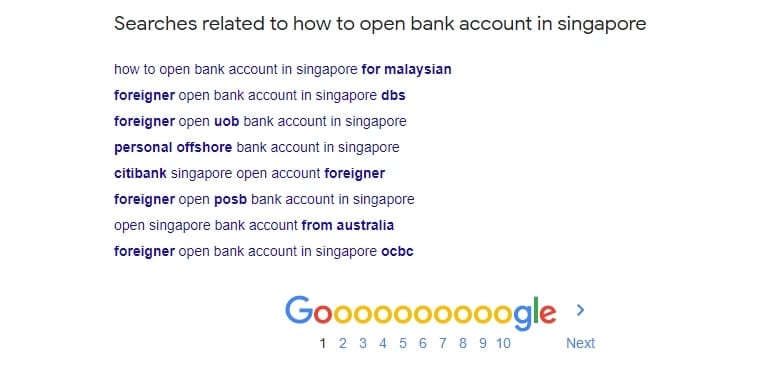
With all these suggestions, pick the keywords related to your ad content, then copy and paste them to your current list. After that, you can choose to delete the keywords on your list that have no relevance.
Listen to the target audience
Apart from Google, another source you could use to find highly-qualified keywords are social media platforms such as Facebook, LinkedIn, Twitter, Reddit, or Instagram.
Go to pages or groups on these social networks where your target audience talks to each other and intentionally look to the exact words they use on different topics related to your market, products, or services. Using advanced market research tools to facilitate your searching process.
These words with high using frequency are potential keywords for your ads. Only when putting yourself into your customers’ shoes you are able to create money-making keywords.
Scout your competitors
Once your brainstorming process finishes, it’s time to analyze your competitors for valuable information that can expand your list. You should do this before diving into different keyword research tools (which I will mention later).
A business can learn a lot from their direct competitors on how they are launching their ads and what keywords they are bidding most on, or who else is bidding on the keywords you want, etc.
The easiest way to check your competitors is:
- Google your main keywords
- Look at the first three search results
- Click on and check the words your competitors used and determine whether you want to get them on your list or not
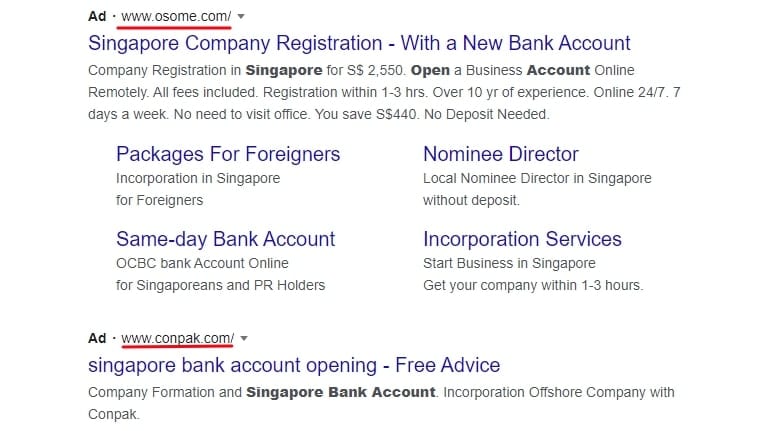
However, that is not enough and should only be used as a double-checking tactic. It’s possible for you to get support from specialized research keyword tools outside the market.
These collected data will allow you to distinguish between terms that are worth your money and ones that can chew your budget with little return.
Expand Your List Using Keyword Researching Tools
With a decent list of keywords to bid on to fill the gap in your coverage, your next step is to define which keywords to keep and which to drop using keywords research tools.
Of course, there are tons of keyword research options available these days under the impact of advanced technology. The problem is which one that works best for your business.
Some great tools to generate hundreds of keyword suggestions:
- Ubersuggest
- Keywordtool.io
- Google Keyword Planner
For the competitor’s keyword analysis, one of the most crucial stats you should consider is the search volume.
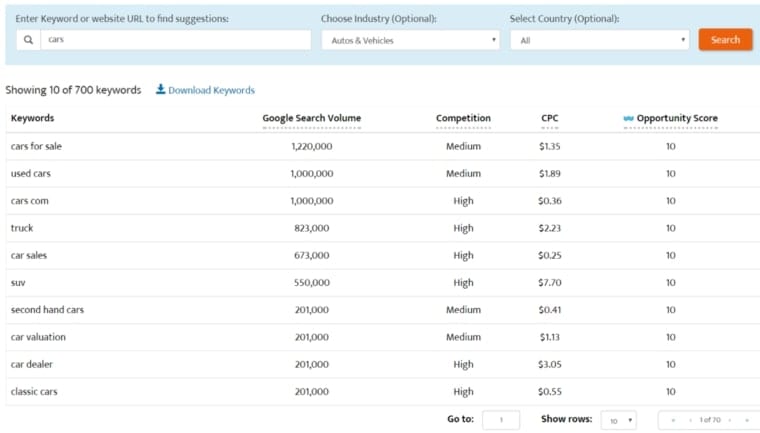
You will want the keywords that have all of the following conditions:
- Have a high search volume
- Avoid the terms that have little or no search volume
- Low competition
The keywords with higher search volume will cost more money to bid on. That’s why you should consider carefully before deciding to invest in these types of keywords. Meanwhile, there is no ensuring that the vast majority of leads generated via high-volume keywords will buy your products.
Trying some keywords that are not too broad and specific to your niches can be a solution. Once your checking process finishes, you can keep the potential keywords that are not overly competitive and high-cost keywords.
With the support of keyword tools, you can prune back certain keywords while discovering more unexpected keyword ideas.
Niche Down Your Keywords With Specific Description
As you get your way through these instructions now, you are ready for the next step on optimizing all of your selected keywords. This step is where you make your terms more specific as well as better define your offerings using long-tail keywords.
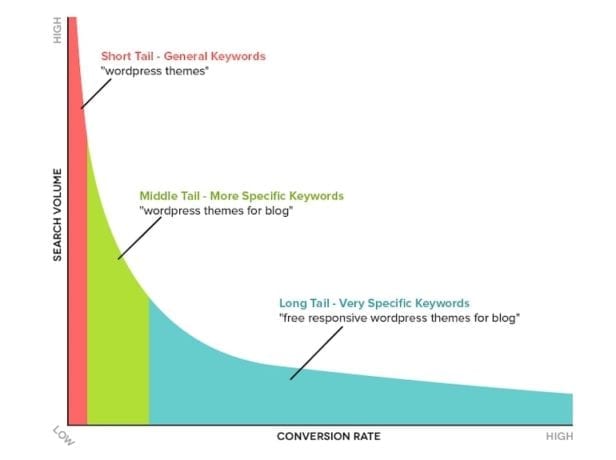
Source: Seopressor
Targeting long-tail keywords is a strategy used widely for both SEO and PPC by marketers to tailor their content creation efforts. It’s valuable for PPC campaigns for several reasons:
- Lower cost and less keyword competition
- High targeted and relevant to voice search
They generally have higher conversion rates compared to head and mid-tail terms. That’s why though most companies choose to run their paid campaigns using broad keywords, the long-tail keywords are still a worthy investment.
Consider all types of modifiers to find these niches:
- Location (city or state)
- Age and gender of target customers
- Price point (bargain, mid-range, luxury)
- The features of products or services
You can start with broad keywords, then niche them down with the product’s detailed descriptions, for example:
Dress -> Women’s Dress -> women’s long-sleeve dress -> women’s brown long-sleeve dress.
Sorting and Organizing Your PPC Keywords
Your next job is to sort your list into small and high targeted groups of keywords to optimize PPC campaigns’ performance.
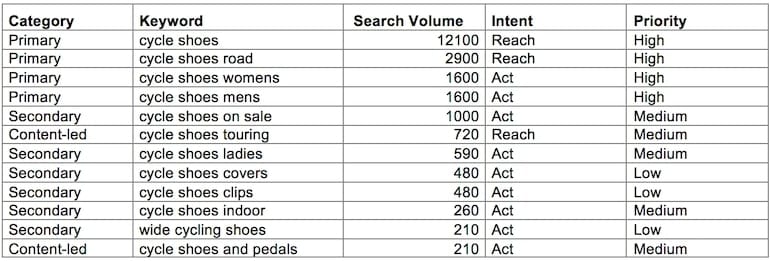
The more focused your ad groups are, the easier it can be for you to:
- Monitor and measure the effectiveness of each keyword group
- More comfortable to prune or expand the keywords corresponding to different ad groups
- Create a chain of highly specific and relevant ads
- Increase the influence of each ad group on aiming at the customers belonging to different parts of the sales funnel
A proper keyword grouping and organization will help your marketing process stay organized and target the right customers, hence reducing your costs.
As a result, well-organized campaigns with higher relevance will lead to better Quality Scores, which simultaneously drive ad rankings and reduce PPC (Pay per click) rate.
Don’t Forget Negative Keywords
Negative keywords are terms and phrases you intentionally don’t want to have in your ads. With these kinds of keywords in your campaign, the failure is apparent.
The purpose of avoiding these keywords is to prevent your ads from showing up alongside search queries that are irrelevant, offensive, or don’t fit user intent.
For example, a luxury hotel chain can never reach affluent customers with terms like “cheap” and “free.”
Some tips for finding negative keywords for your PPC campaigns:
- Always check your search query reports: For terms that are not a good fit for your ad purpose, define them as negatives from the setting before launching the ad
- Define negative match types: The match type you assign to a negative keyword has an enormous impact on what traffic it blocks. Disqualify any query containing negative terms
- Research negative keyword options: The more negatives you set before a campaign goes live, the more cash you’ll save right off the bat
Though eliminating negative keywords on your ad is essential, don’t go overboard. Improper use of negative can harm your account while killing the impression volume of your ad.
Spend your budget on terms that actually drive revenue!
If you hope to succeed in the world of paid ads, you have to find a way to distinguish your brand from competitors. And keyword research optimization is just one of the first steps in getting your ads ready.
Suitable tactics on keyword research will ensure your paid campaigns are always well-targeted and relevant to the targeted audience.


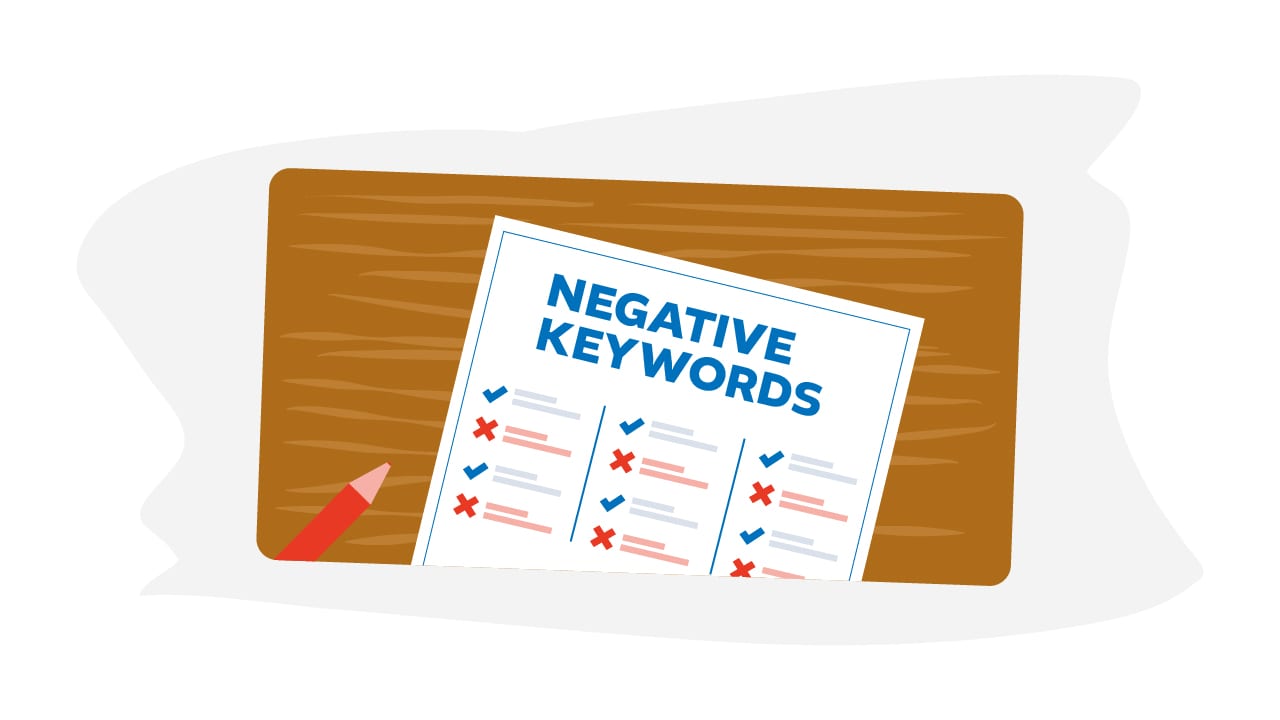


Leave A Reply